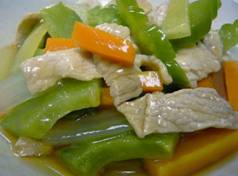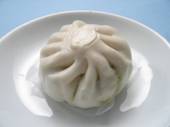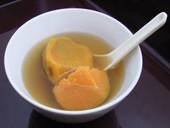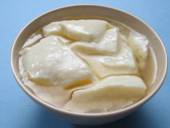Menu Planning for People with Chewing Difficulties
According to the Oral Health Survey conducted by the Department of Health in 2011, the average number of teeth remaining in institutionalized elders was 9.4. Almost 30% of the institutionalized elders had no teeth at all. About 17.5% and 16.3% of the institutionalized elders expressed difficulties in chewing and discomfort on eating respectively.
Due to tooth loss and other health condition like weakness after stroke, chewing problem is common among elders. This limits food intake, and may subsequently impact the nutritional status. Other detrimental factors on the nutritional status include unappealing foods, monotonous meals, and unbalanced diet.

* Dishes in three different textures
Therefore, planning the menu properly to meet the nutritional needs of elders with poor dentition and chewing difficulties is of utmost importance. By using a systematic way of planning menu, selecting appropriate ingredients and practising healthy cooking methods, the meals can become nutritionally complete and palatable.
Menu planning concepts
- Plan the menu according to the principles of the Healthy Eating Food Pyramid which emphasizes variety, balance, and the right proportion of different foods groups.
- Use healthy ingredients / food items and low-fat cooking methods:
- Use foods that are high in fibre, such as oatmeal, vegetables, fruits, and dried beans, etc.
- Use lean meat, skinless poultry, fish, or dried beans; avoid using high-fat meat, such as fatty cut of pork, chicken wings, etc.
- Use natural seasoning that is low in sodium, such as ginger, green onions, and garlic; avoid using foods that are highly salted (processed meats, preserved vegetables, condiments), such as salted fish, salted mustard root, fermented soybean curd, shrimp paste, etc.
- Limit foods that are high in sugar and fat, such as cakes, cookies, etc.
- Use low-fat cooking methods, such as steaming, boiling, braising, etc.
- Make a good combination of various foods to enhance the variety of dishes and help stimulate appetite.
- Use food ingredients that are in season, as they are often more delicious and lower in cost.
- Plan three main meals and add one to two snacks in between meals throughout the day.
Steps in menu planning
- Plan the main dishes in lunch and dinner first, then soups, breakfasts, and finally snacks and fruits.
- Sequence of selecting food ingredients at different meals:
- Lunch and dinner:
- Main dish: Select the meat choice of main dish first. Then, build the rest of the meal around the meat item by choosing vegetables that will enhance the appeal and attractiveness of the total meal.
- Soup: Select the meat choice, and then accompany it with vegetables to complement the meal.
- Lunch and dinner:
- Breakfast: Select the grains item, and then add meat, vegetables, or dairy products in conjunction with the grains item selected.
- Snacks and fruits: Consider variety and avoid repetition.
Food choices chart
| Foods to choose | Foods to avoid | |
|
|
|
| Vegetables | Vegetables that are well cooked and soft, such as wax gourd, carrot, and leafy greens with tender leaves and shoots, such as amaranth leaves, spinach, etc. | Vegetables that are hard, stringy, and rubbery, such as kale, lotus root, celery, corn, etc. |
| Meat, Poultry, Fish, Eggs, and Dried Beans | Meats that are skinless and boneless, such as minced pork, shredded chicken, small chunks of tender beef, flaked fish, eggs, soft tofu, etc. | Meats that are tough, chewy or with bones, such as beef shin, squids, spareribs, etc. |
| Fruits | Fruits that are soft, such as small pieces of banana, papaya, etc. | Fruits that are dry, hard, and fibrous, such as dried fruit, apple, pineapple, etc. |
Remarks: Wise use of food processors to cut foods into small pieces
 *Stir-fried pork slices with bitter melon and carrot |
Main dish ideas
|
Making the menu items more attractive and appetizing
Visually attractive and tasty foods can stimulate the appetite and improve food intake which leads to good nutritional status. Try to make the meals more attractive and appetizing by making use of different colour of foods and aromatic ingredients.
- Colour: Consider combination of colours and use colourful ingredients to increase the visual appeal; for example, cooked carrot is tasty and also appealing, and adding shredded carrot to leafy greens offers inviting colour combination.
- Aroma: Use natural seasoning, such as ginger, green onions, garlic, and other aromatic vegetables like leafy greens, turnip, mushrooms, onions and fruits to enhance flavor, and to reduce the use of high-sodium condiments.
Planning snacks between meals
- Since elders suffering from chewing difficulties may not be able to meet their nutritional needs only by having the main meals, planning nutritious snacks can help increase the overall food intake to meet their body’s needs.
- Healthy snacks ideas:
- Tuna and lettuce sandwich served with low-fat milk / steamed chicken bun served with calcium-fortified soy milk
- Desserts: soybean curd dessert, sweet potato sweet soup, etc.
 |
 |
 |
| Steamed Chicken Bun | Tuna sandwich with shredded lettuce | Low-fat Milk |
 |
 |
|
| Sweet Potato Sweet Soup | Soybean Curd Dessert |
Three-day sample menu
| Day 1 | Day 2 | Day 3 | |
| Breakfast |
|
|
|
| Lunch |
|
|
|
| Afternoon Snack |
|
|
|
| Dinner |
|
|
|
| Fruits |
|
|
|
Individual elders have variable levels of tolerance to different food textures. Health professionals should be consulted to assess individual cases and give recommendations on the appropriate food texture and consistency.
*Acknowledgment: Dish photos provided by the Lam Woo Memorial Day Care Centre for the Elderly of the Hong Kong Young Women’s Christian Association.
